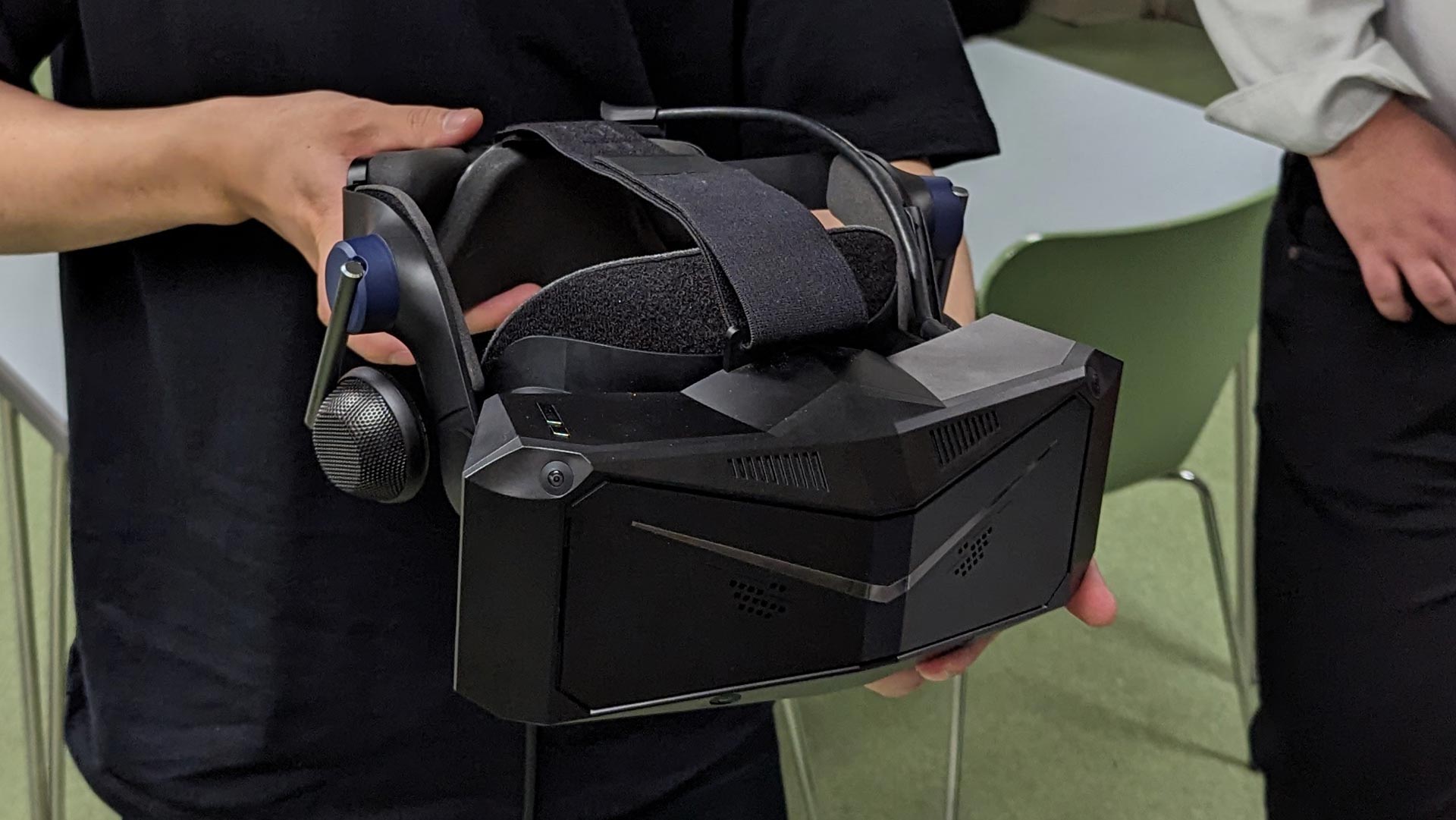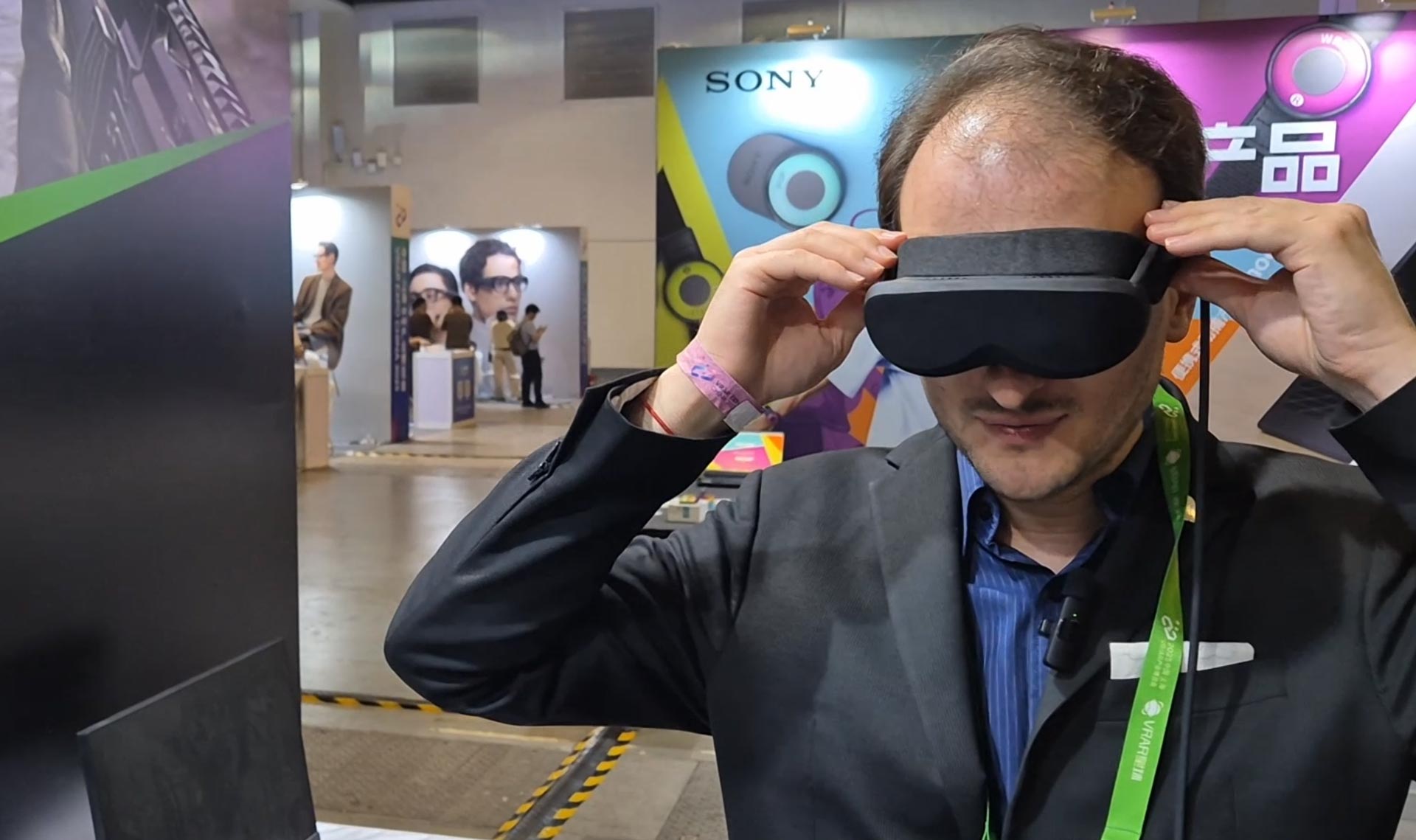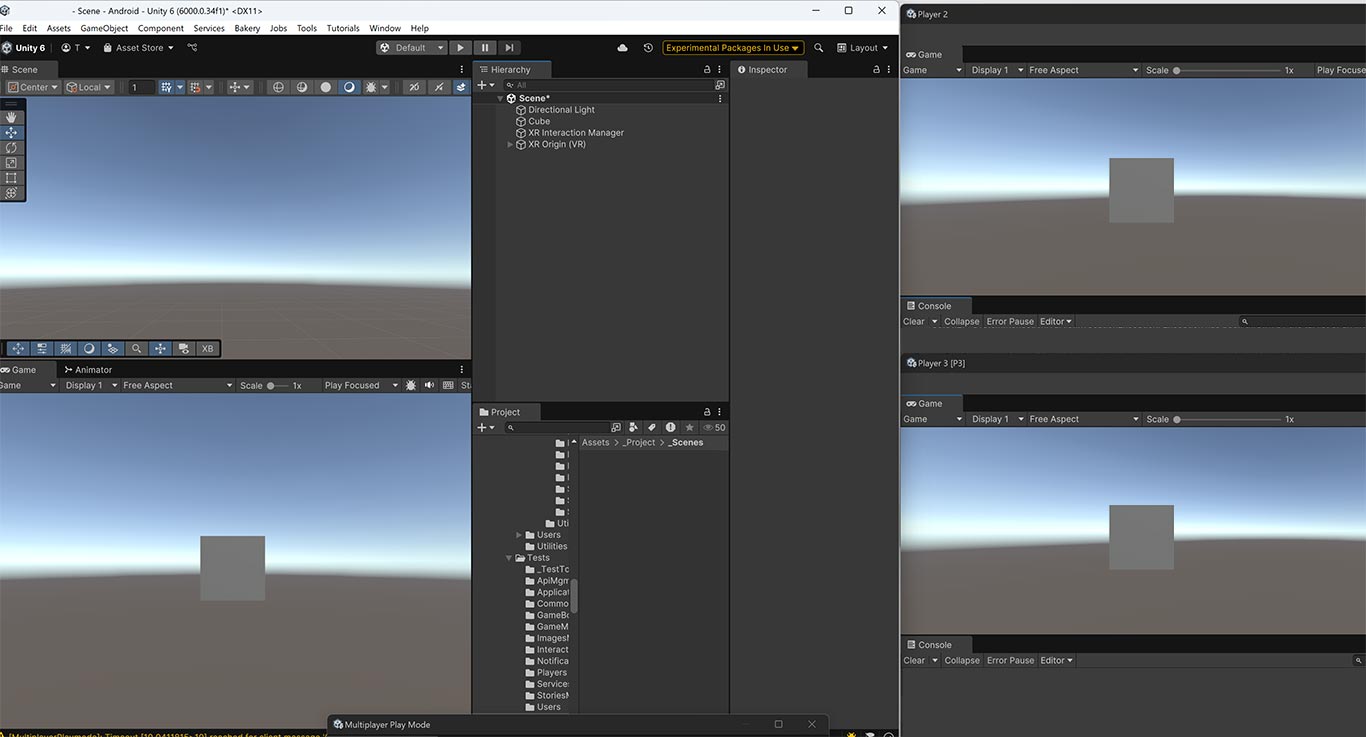Hands-on the Pimax Crystal Light at Pimax Global Roadshow London 2024
Today I host another amazing guest article by Rob Cole, the VR ergonomics expert who has ideated the XR Caliper (later XR Modular) controller and has reviewed headsets like the Pimax Crystal already on this blog. Today Rob will tell us about his experience at the Pimax Global Roadshow episode that happened in London a few weeks ago. Let’s see how this event by Pimax turned out to be! Rob, the mic (or the keyboard) is yours…

Following the recent news that Pimax was launching a “Light” version of their Crystal VR headset, there was soon talk of a Pimax Global Roadshow passing through several US and European Cities during the Summer of 2024.
After receiving an invite by email, I made a booking for a demo session at the London leg of the Pimax Global Roadshow which was taking place on Wednesday 5th June. It was very handy that it was only a half-hour walk from my house!

So in case you missed the recent news, what is the Pimax Crystal Light? It’s a stripped-down version of the original Crystal, purely for tethered PCVR, at an aggressive price point for a headset of its class (35ppd). It’s aimed at Reverb, Vive Pro, and Index owners looking for a visual upgrade. Pimax additionally offers a SteamVR faceplate for those already using Lighthouse base stations and Index controllers.
Gone is the XR2 processor, taking with it the Standalone mode and wireless support; gone is the Tobii eye tracking with automatic IPD and Dynamic Foveated Rendering. Thankfully also gone is the removable battery with its rear cradle and semi-rigid power strap.
Eliminating all of these components removes a reported 300 grams of weight, much taken from the front to give what should be a more balanced headset with less inertia when moving quickly.
These are the specifications of the headset, according to Pimax:
- Ultra-sharp 2880 x 2880 resolution per eye.
- Glass aspheric lenses with a large sweet spot.
- 35 PPD for super clear vision.
- Variable refresh rate (60Hz, 72Hz, 90Hz, 120Hz) provides smooth gameplay.
- Manually adjustable IPD (58-72mm).
- Foveated Rendering: Fixed 2.0.
- Easy setup with inside-out tracking or expand with Lighthouse tracking.
- Audio: interchangeable 3.5mm jack, 2x microphone.

Crystal Light options include the following, with pricing shown below in GBP but excluding tax and shipping. There is also a new “trial payment” at a reduced price with the final balance due after the 15-day trial, if you decide to keep the product.
- Pimax Crystal Light with local dimming, no controllers £649
- Pimax Crystal Light with local dimming, Pimax Controllers £729.00
- Pimax Crystal Light with local dimming, no controllers, SteamVR faceplate £729
There is also mention of a version with no local dimming as “coming soon” with just a US dollar price at $699… perhaps something for the future then? (since going to press, Pimax announced a small delay due to the display panels). Pimax has already shipped a sizeable number of Crystal Light headsets to pre-order customers so expect to see reviews popping up on your favourite VR channels and websites soon.
Of course, there will be an exclusive in-depth review for the Skarredghost once a Crystal Light production headset is received for testing, which shouldn’t be long after this article is published.
Finding the London Roadshow
A couple of weeks later, we found the London leg of the Pimax Global Roadshow hidden away in the sub-basement of a public library on a small housing estate between Regent’s Park and Edgware Road. Quite a strange location, but temporary rentable space is at a premium in many big cities, so it’s great they actually found an accessible location in central London.
It was a busy trading day in Church Street with a thriving street market, bustling with large numbers of people buying fruit and veg; the entrance to the library provided a slightly surreal portal for our VR demo.

A helpful front desk inside the library pointed us in the right direction, descending several sets of stairs, at first finding a “gaming centre” packed full of desktop PC gaming setups for community use. This looked promising, but wasn’t it. However, in a room next door, we saw people in black Pimax t-shirts carrying computer equipment and headsets.
We had a quick talk with one of their staff members, who turned out to be their Chief Operating Officer. Following her friendly introduction, she asked some questions about VR which I was more than happy to answer.

Two Crystal Light headsets were set up with gaming PCs (RTX 3070 and RTX 3080) on small tables whilst an original Crystal was being set up on a third PC, with the wireless 60G module and some driving sim equipment. Before my demo it was time for a quick look at the new headset, to see what had changed compared to the original Crystal.
The Pimax Crystal Light
I had been using a Pimax-supplied original Crystal for nearly a year with the fibre optic cable, DMAS speakers, and SteamVR faceplate, so had some solid experience under my belt (including 55 hours of “Into the Radius”) which I felt would give me a useful comparison between the Crystal and Light headsets (you can read about my previous experience with the Crystal here: https://skarredghost.com/2023/12/28/pimax-crystal-review-versatile-headset/)

Most noticeable was the weight reduction when picking up the headset, whilst creating a better balance between the front and rear, with less weight on the front. From what Pimax has said, the Light is about 300 grams lighter than the original Crystal, not surprising with the removal of the XR2 processor, eye tracking chip and lens array, the motorised IPD adjuster, rear battery with housing cradle and top power strap, DP repeater box, etc.
Stripping down the headset so people could play SteamVR and OpenXR games at an affordable price with minimal fuss was a smart move. The Crystal Light presents as a 2880×2880 DisplayPort headset containing high-specification QLED panels with local dimming option, aspherical glass lenses, competent inside-out tracking with Touch-style controllers, and a simple tethered connection.
Ditching the standalone system and moving to a PCVR headset made a lot of sense considering the very high financial cost of populating a competing standalone VR store with compelling enough software to entice people into a new ecosystem. When I last looked, there were only a dozen apps on the Pimax standalone store, and nothing new had been added since launch.
Even established competitors like HTC and Pico have struggled to get this element right, with Meta and Valve taking the majority of VR software sales. Getting customers and developers to sign up for another competing store, especially one sparsely populated, was proving an uphill battle. Since Pimax makes money by selling hardware, it made sense to focus on the physical by leaving the multi-billion dollar companies to battle for software sales in a subsidized market.

Picking up the headset, I found a new and much improved wider top strap which replaces the original “power strap” and underslung “top strap” combo. This should provide a big improvement in terms of user comfort from the thicker, wider strap material giving more support and stability as well as much improved ease of adjustability when setting up your fit.
If sharing the headset this is also very beneficial as the original Crystal top strap was tricky to adjust as it was hidden under a thick power strap, and was not particularly supportive out of the box, leaving a number of enthusiasts to mod their head straps.
The Pimax Comfort Top Strap for the original Crystal has been confirmed by Pimax as being compatible with the Crystal Light, for users who are spending long hours in their simulator and want the increased comfort from its Aero-like adjustable top cradle design. As someone who finally received my Comfort Top Strap (from Amazon) I can confirm it made a big difference to my original Crystal, so well worth looking into as an option.
At the rear of the headset, the battery cradle has gone, replaced by a new padded rear cradle with a large knurled dial for fitting the headset. In combination with the top strap, it should fit across a wider range of head sizes and shapes as the power strap length on the original Crystal could be a limiting factor for larger-sized heads.
The mechanical IPD adjustment is granular with a range of 58-72mm, with additional software offsets to be found in the Pimax Play PC client software which has its own version for the Crystal Light.
The demo headset I used was fitted with the off-ear DMAS speakers, whilst the other demo headset had the regular SMAS which comes with every headset. The DMAS speakers are an added extra normally selling at GBP £80 which seems reasonable for an Index-style audio upgrade using BMR drivers from Tectonic who also supplies the drivers in Valve’s Index. Now that Reverb G2 and Index are EOL, this leaves Pimax as the only vendor offering extra-aural BMR audio.
Trying the Crystal Light headset
Being very familiar with the Crystal, I quickly adjusted the Crystal Light to suit my 59cm head. The wide top strap with a large velcro tab made for a big improvement in fitting and immediate comfort.
The headset was fitted with the comfort face cushion which I don’t personally use in my Crystal: I started with the regular face cushion bolstered with velcro side pieces to narrow the cushion. I’m now using Studioform Creative’s Crystal kit which has some great pieces to really dial in the fit.
For this demo, the headset felt a little too wide but actually felt quite stable from the new top strap and reduced weight. I’m sure with some ergonomic modifications to suit my fit it would be further improved and this is something to look forward to trying with my test headset in the future.

Jumping into “The Blu”, the Crystal Light looked super sharp and had surprisingly lost the chromatic aberration and colour shifting I sometimes experienced in my original Crystal.
The optics definitely seemed sharper, perhaps the non-removable lenses benefitting from locked-down factory calibration, or a year’s worth of manufacturing experience has made for a better set of glass lenses than those found in my original Crystal? Whatever the explanation, I was really impressed with the optics, which also seemed to have a marginally improved field of view.

Looking through the SteamVR library on the host computer, I tried a number of different experiences including Pistol Whip which is always a great work out for tracking systems with its rapid gunplay. I was impressed with the performance of the inside-out tracking: I tried occluding the controllers and moving them out of range to test their limits, and they performed as expected similar to Meta and HTC inside-out tracking.

I actually had a better performance of the inside-out tracking at the demo than I get at home with my original Crystal, probably because of the library environment being relatively cluttered giving the SLAM tracking something to lock onto. At home I had some tracking issues with my original Crystal until I switched to the SteamVR faceplate, but I should point out that my home SteamVR room is a worse-case scenario for SLAM with white walls and a black rubber floor devoid of furniture or paintings.
My final test was using Half-Life: Alyx which is often a great benchmark for image quality due to its high-quality assets. I was also keen to try the “fixed foveated rendering” which was one of two tools (the other being upscaling) included in the new Pimax Play client to help offset the heavy rendering cost of Pimax’s 35ppd distortion profile. To give an idea of some numbers, SteamVR reports 100% resolution for my Crystal as 4312 x 5104 per eye, which my RTX4080 finds difficult to render even at 72hz.

Switching FFR to maximum, I noticed something strange in HLA whilst standing in a dark corridor looking at a stationary ventilation fan directly in front of me. The centre of my vision was pixellated and low resolution like an old Doom game, with very large aliasing steps. Turning off FFR made this phenomenon disappear, rendering my entire field of view in high clarity.
Pimax was aware of this bug which seemed to have something to do with HLA and its game engine, so nothing to worry about as the headset has already had a software update since my demo.
Finishing my demo, I was super impressed with the visual clarity of the software I tried, excluding the weird FFR bug in HLA. Finally, I had another good look over the headset, and checked out the new tether, as I was curious to see if the longer and thinner fibre optic tether could be fitted to the Crystal Light.

Crystal Light has a new tether which is a copper DP cable with an inline power injector running off a mains power supply. This should ensure plenty of power is available, doing away with the original Crystal’s need to swap batteries every couple of hours or run additional USB cabling to support batteries during long sim sessions.
Sadly I learned that the fibre optic cable won’t fit, but the copper DP tether should work out fine for simming and roomscale use, and as one early reviewer found, it’s not difficult to use active DP and USB cabling to add a little extra length if required.
Next, I had a look at the other Crystal Light headset which had the stock SMAS speakers. I didn’t get to try them out so cannot comment on the sound quality which I’ve read is passable like similar audio systems. The DMAS on my test headset worked really well as usual so I’d recommend paying the extra to bring Index-style audio to the Crystal Light.

Finally I went over and had a look at the 60G wireless module which was being fitted to the original Crystal attached to the third PC they had brought along. Sadly due to time constraints, I didn’t get to try it out, but handled the base unit which felt reassuringly heavy, and had a look at the neat headstrap-mounted dongle that fits onto the original Crystal headset.
Something to be aware of is the fact that wireless is only supported by the original Crystal, which uses its XR2 processor to run the wireless system, meaning the Crystal Light is purely for tethered use. I look forward to testing the 60G once Pimax has a test unit available for shipping.

Before leaving the demo, I spent about 20 minutes with a prominent Youtuber who runs a flight sim channel, he was filming people attending the Roadshow. Lots of questions were asked about my experience with the Crystal headsets, Pimax and VR in general. It was strange to be on the other side of the camera, but hopefully they gleaned some useful data from my ramblings!

As we were leaving the Roadshow, more guests were arriving for their demo session, so we had a good look around and noticed people were having great fun checking out the latest VR equipment. There was a good buzz about the Crystal Light with positive feedback from people I spoke to, some quite shocked about the increase in clarity because they were used to previous generation headsets.
The general consensus was that Pimax had scored a good win here, making the Crystal Light available for open demonstration, bolstering confidence in the product and the company itself.

It’s great to have these kinds of demo events, as sadly they have been mostly missing since the VR golden days of 2016-2018. Back then it was easy for me to walk into London’s West End on a Saturday morning and try out the Vive, Rift CV1, Daydream, GearVR, and PSVR at different retailers all in short succession.
As the initial hype faded other products replaced the VR demos, and then of course Covid happened, first of all putting a stop to any public events, and afterwards making people nervous about sharing facially worn equipment. This fear seems to have faded for many now, as location-based entertainment venues are reporting good business, and people seem more comfortable sharing with venues adopting lightboxes and other cleaning solutions.
As I learned many years ago, getting heads into headsets is a proven sales tool, as VR really has to be tried to be believed, especially for the latest headsets with higher resolutions and new lens technology providing big improvements in optical clarity. The days of 13ppd headsets and fresnel lenses are surely numbered…

From my brief demo of the Pimax Crystal Light, I came away impressed with the product itself and the low pricepoint (compared to original Crystal) which should allow a larger number of VR users to get on board the next-generation train without blowing the bank. I was also impressed with Pimax putting on a good show at many locations across Europe and the US. Other companies could learn from this, as there is nothing better than meeting your customers directly.
Big thanks to Pimax and their friendly staff for organising the London event, my thanks to you the reader, and to the Skarredghost for hosting my article.
(Header image by R. Cole and S. Ramos)
Disclaimer: this blog contains advertisement and affiliate links to sustain itself. If you click on an affiliate link, I'll be very happy because I'll earn a small commission on your purchase. You can find my boring full disclosure here.



